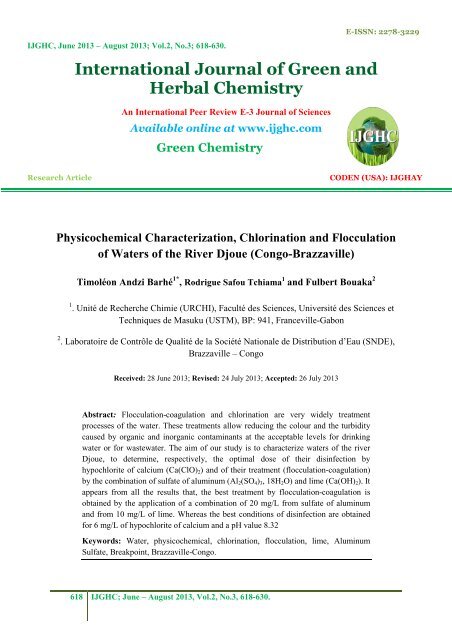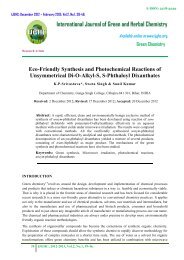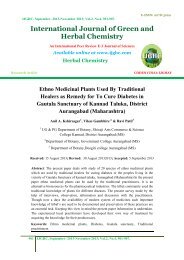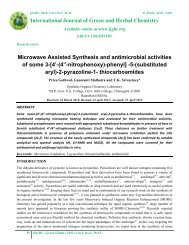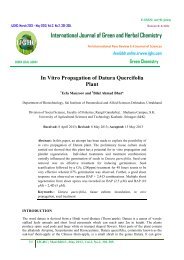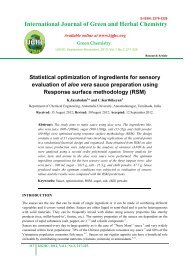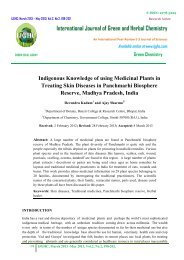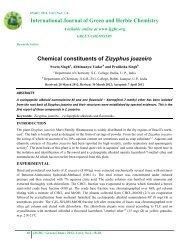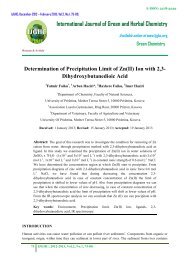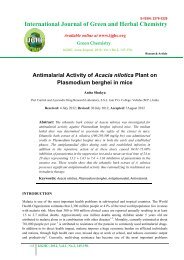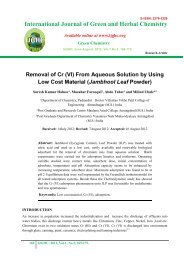Physicochemical Characterization, Chlorination and ... - IJGHC
Physicochemical Characterization, Chlorination and ... - IJGHC
Physicochemical Characterization, Chlorination and ... - IJGHC
You also want an ePaper? Increase the reach of your titles
YUMPU automatically turns print PDFs into web optimized ePapers that Google loves.
<strong>IJGHC</strong>, June 2013 – August 2013; Vol.2, No.3; 618-630.International Journal of Green <strong>and</strong>Herbal ChemistryAn International Peer Review E-3 Journal of SciencesAvailable online at www.ijghc.comGreen ChemistryE-ISSN: 2278-3229Research ArticleCODEN (USA): IJGHAY<strong>Physicochemical</strong> <strong>Characterization</strong>, <strong>Chlorination</strong> <strong>and</strong> Flocculationof Waters of the River Djoue (Congo-Brazzaville)Timoléon Andzi Barhé 1* , Rodrigue Safou Tchiama 1 <strong>and</strong> Fulbert Bouaka 21 . Unité de Recherche Chimie (URCHI), Faculté des Sciences, Université des Sciences etTechniques de Masuku (USTM), BP: 941, Franceville-Gabon2 . Laboratoire de Contrôle de Qualité de la Société Nationale de Distribution d’Eau (SNDE),Brazzaville – CongoReceived: 28 June 2013; Revised: 24 July 2013; Accepted: 26 July 2013Abstract: Flocculation-coagulation <strong>and</strong> chlorination are very widely treatmentprocesses of the water. These treatments allow reducing the colour <strong>and</strong> the turbiditycaused by organic <strong>and</strong> inorganic contaminants at the acceptable levels for drinkingwater or for wastewater. The aim of our study is to characterize waters of the riverDjoue, to determine, respectively, the optimal dose of their disinfection byhypochlorite of calcium (Ca(ClO) 2 ) <strong>and</strong> of their treatment (flocculation-coagulation)by the combination of sulfate of aluminum (Al 2 (SO 4 ) 3 , 18H 2 O) <strong>and</strong> lime (Ca(OH) 2 ). Itappears from all the results that, the best treatment by flocculation-coagulation isobtained by the application of a combination of 20 mg/L from sulfate of aluminum<strong>and</strong> from 10 mg/L of lime. Whereas the best conditions of disinfection are obtainedfor 6 mg/L of hypochlorite of calcium <strong>and</strong> a pH value 8.32Keywords: Water, physicochemical, chlorination, flocculation, lime, AluminumSulfate, Breakpoint, Brazzaville-Congo.618 <strong>IJGHC</strong>; June – August 2013, Vol.2, No.3, 618-630.
<strong>Physicochemical</strong>...Andzi et al.INTRODUCTIONThe water constitutes a more <strong>and</strong> more rare, vulnerable <strong>and</strong> with difficulty renewable foodstuff. Ofthis fact awareness imposes to manage it in a rational way <strong>and</strong> to worry about effects of the quality ofwaters on the ecosystems, but especially on the public health. It is thus important that water resourcesare effectively protected against any nuisance <strong>and</strong> that they are treated to produce water which thequality satisfies biological <strong>and</strong> physicochemical st<strong>and</strong>ards of drinkability.Our study is centred on the characterization of the specific problems of quality <strong>and</strong> treatment of thewater of river Djoue, mobilized for the production of the drinking water in Congo-Brazzaville.This water contains organic matters resulting from plant <strong>and</strong> animal life. This organic load isconstituted for the greater part, by humic substances 1 . Their presence in natural waters involvesnumerous problems, because they are responsible for the coloring of waters, for the complexation ofseveral toxic matters. Also, halogenated compounds may form by oxidation of these substances 2 .Various processes are used for the water treatment of surface, among which, the physicochemicalprocesses such as: the disinfection <strong>and</strong> the coagulation-flocculation.Disinfection of drinking water can be regarded as the most significant public health measure takenduring this century 3 . Destroying pathogens form drinking water has dramatically reduced theincidence of water-n transmitted diseases in all industrialized countries 4 . Over the past century,chlorination in the form of hypochlorous acid has become the most common method of disinfectingwater 5 . This use has come about because of chlorine powerful disinfecting capabilities against bothbacteria <strong>and</strong> viruses, it’s easy application <strong>and</strong> low cost 6-10 . Chlorine can be supplied as calciumhypochlorite (Ca(ClO) 2 ). Under alkaline conditions (pH > 7.5) the disinfectant capability of dissolvedhypochlorite is limited. On the other h<strong>and</strong>, at low to moderate acidities (pH < 7.5) the salt exist mainlyas hypochlorous acid (HOCl), which is about on thous<strong>and</strong> times more effective as a disinfectant thancompletely dissociated hypochlorite ion 11,12 . The major part of water chlorine dem<strong>and</strong> is due tooxidation processes 13 . However, the possible substitution of hydrogens in the molecules leads toformation of halogenated compounds by reaction of the oxidation on both the organic <strong>and</strong> inorganicmater of the treated water 14,-16 .The principle of the flocculation-coagulation is based on the destabilization of particles in suspensionby the injection <strong>and</strong> the fast dispersal of chemicals compounds (coagulant) to favor theirconglomeration <strong>and</strong> allow their decantation. The most difficult particles to eliminate in waters are theones which possess a very small size (colloidal particles responsible for the turbidity) <strong>and</strong> those whichare dissolved (organic matters responsible of the tint). These colloids usually carry a negative electriccharge which prevents the particles to agglomerate the some in the others to form more voluminousparticles (plop) <strong>and</strong> facilitate their elimination by sedimentation <strong>and</strong> filtration.The aim of the coagulation-flocculation is to neutralize the negative charge of these particles to favorthe formation of agglomerate. To do it, we usually introduce in the water the coagulant, mostly iron oraluminum salts. Mechanisms driving to the destabilization of colloids were widely studied 17-20 <strong>and</strong> canbe recapitulated as follows: the neutralization of charges relaying on the sufficient addition of cationsto neutralize the stable negative charge of particles. This mechanism meets only in acid pH (pH value< 5.5). In this case, the dominant species of the coagulant are positively charged (Al (OH) 2+ , Al(OH) 2+or Al 2 (OH) 2 4+ ). On the other h<strong>and</strong>, the overdose of coagulant, source of cations can cause a tooimportant adsorption of cations <strong>and</strong> invert the charge of particles which becomes positive. Theparticles would so be restabilized 21 . The imprisonment <strong>and</strong> the adsorption of colloids on aluminumplops are made when sufficiencies of Al 2 (SO 4 ) 3 , 18H 2 O) are added. In return, when pH valueincluded between 5 <strong>and</strong> 8, the coagulant is in the hydroxide of aluminum (Al (OH) 3 ) form 20 ,619 <strong>IJGHC</strong>; June – August 2013, Vol.2, No.3, 618-630.
<strong>Physicochemical</strong>...Andzi et al.possessing generally interesting properties of adsorption. The pH value of the water has to be situatedin optimum range where we have coexistence between the coagulative forms <strong>and</strong> the plop form. Theplop gets in touch with the particles of negative charge <strong>and</strong> imprisons them. Particles are theninvolved during the decantation. The performances of this technic are revealing by several authors <strong>and</strong>on different coagulant 22-29 .The objective of this study is on one h<strong>and</strong>, to realize a physicochemical characterization <strong>and</strong>chlorination, in the hypochlorite of calcium, <strong>and</strong> on the other h<strong>and</strong>, to determine the optimalconditions of treatment implementing the combination of lime <strong>and</strong> sulfate of aluminum to reduce atmost the organic matter <strong>and</strong> thus the formation of toxic matter during the chlorination 30-32MATERIALS AND METHODSSampling: After several sampling at diverse places of the river, an average sample was set up foranalyses in laboratory. The transport of samples since the taking point <strong>and</strong> the laboratory is made inan icebox at 4°C. When samples are preserved, they are put in the refrigerator. At the time of thedosages, samples are homogenized before proceeding to the analytical operationsMethods of dosage:• The mineral elements <strong>and</strong> suspension materials (SM) were measured by colorimetry usingColorimeter DR / 890 " of " Hach Be Right 48471-94 "• pH <strong>and</strong> temperature with pH-meter HANNA " Hi 991001 "• The conductimetry <strong>and</strong> the quantity of dissolved solid (TDS) with conductimeter “ WTWCond. 340i” of HACH• Turbidimeter «ELAMOTTE 2020e" is used to determinate the turbidity.pH Correction with Calcium hydroxide (Ca(OH) 2 ):100 ml of sample are taken in a becher of 250ml. We add in the becher a pinch of Calcium Carbonate (CaCO3). After stirring, let sit the mixtureduring 15 minutes, then we measure balance pH. We dispose 6 becher of 250 ml containing each 100ml of sample. We add in every becher, increasing volumes of calcium hydroxide [Ca(OH) 2 ] at 10 g/L.after roughness, <strong>and</strong> let sit during 15 minutes, we measure the pH in every becher. The becher whichwill have a pH near the equilibrium pH will allow us to determine the rate of treatment.Disinfection with Calcium hypochlorite (Ca (ClO) 2 ):We arrange 10 becher of 150 ml containingeach 100 ml of sample. In every becher, we add increasing volumes of Calcium hypochlorite (10 g/L).We shake <strong>and</strong> let sit during 30 minutes. After 30 minutes, by the colorimeter method, we measuretotal chlorine <strong>and</strong> residual chlorine in every becher, using the DPD (N, N, diethyl phenyl diamine) asreagent. The DPD gives a red color with chlorinated sample. With the values of total chlorine <strong>and</strong>residual chlorine, we draw the curve of disinfection to determine the rate of treatment in Ca(ClO) 2 .This rate of treatment is a minimum point of the curve called: breakpoint.Treatment of clarifying: The Jar test assays are realized with Stuart SW6 flocculator, by using asolution of sulfate of aluminum to 10 g/L. We arrange 6 bechers of 1000 mL containing each 500 mLof sample. We add in every becher, increasing volumes of sulfate of aluminum (Al 2 (SO4) 3 , 18H 2 O)<strong>and</strong> hydroxide of calcium (Ca(OH) 2 ) at 10 g/L. We shake quickly during 2 minutes <strong>and</strong> slowly during20 minutes. We let rest during 20 minutes to favor the deposit of the formed plops. Then we measurethe turbidity of every becher. The rate of treatment in the sulfate of aluminum (S.A) <strong>and</strong> the in the620 <strong>IJGHC</strong>; June – August 2013, Vol.2, No.3, 618-630.
<strong>Physicochemical</strong>...Andzi et al.hydroxide of calcium is given by the mixture contained in the becher which has the smallest value ofturbidity.RESULTS AND DISCUSSION<strong>Physicochemical</strong> quality: Table 1 presents the physical characteristics <strong>and</strong> the composition inorganic matters of analyzed waters. We can observe that waters of Djoué River have a slightly basicpH. This pH value (7.5) is in the st<strong>and</strong>ard WHO on waters of drinks 33 . The value of turbidity (15NTU) shows that they are very muddy waters. These results are confirmed by the values of the colour<strong>and</strong> the concentration of suspension materials (SM). The strong turbidity of these waters is an indirectindicator of the microbiological risk that can possess these waters. The main source of theorganohalogenated compounds formation is via the oxidation of the natural organic matter (NOM) 34 .The conductivity indicates a low mineralization, consolidated by a general mineralization lower than600 mg/LTable-1: Characteristic Parameters of the Physical Aspect <strong>and</strong> the Organic MatterParameters Units Sample WHO st<strong>and</strong>ardpH - 7,5 6,5 - 9,00Temperature °C 20 12 – 30Turbidity NTU 15 5Color mg/L Pt-Co 7,5 15Smell - whithout whithoutFlavour - whithout whithoutAspect - trouble -Redox Potential mV 342,28 -T.D.S (Total dissolved solid) mg/L 9 -Conductivity µs/cm 20 -Résistivity Ωcm 50000 -Suspension materials (S. M) mg/L 13 < 1General mineralization mg/L 32,48 < 600Analysis of the mineral nitrogen (Table 2) shows that Djoué water’s presents a low concentration innitrogen. However, this low concentration can be precursory nitro-halogenated compounds duringchlorination. It has been demonstrated how nitrogen-enriched fractions of organic matter have ahigher propensity to form various N-disinfection by products (N-DBPs), including the haloacetonitrils(HANs) <strong>and</strong> halonitromethanes (HNMs) 35 . Algae <strong>and</strong> wastewater are the two most commonly citedsources of dissolved organic nitrogen. These individual DBPs or mixtures of DBPs could represent apotential human health risk 36,-41 .Table-2: Characteristic Parameters of the Mineral NitrogenParameters Units Sample WHO st<strong>and</strong>ardNH 4+NO 2-NO 3-mg/L 0,27 0,5mg/L 0,092 0,1mg/L 0,23 50621 <strong>IJGHC</strong>; June – August 2013, Vol.2, No.3, 618-630.
<strong>Physicochemical</strong>...Andzi et al.Alkalinity analysis (Table 3) give values of strength Hydrotimetric lower than the WHO st<strong>and</strong>ard. Ifwe compare these values with those of the Table 4, which give the WHO st<strong>and</strong>ards for the hardness ofdrinking waters, it appears that water of Djoué River is soft water.Table-3: Alkalinity <strong>and</strong> Fundamental Elements of WatersParameters Units Sample WHO st<strong>and</strong>ardT.A mg /L CaCO 3 0,00 50T.A.C mg /L CaCO 3 10,07 100T.H t mg/L CaCO 3 10,52 150TH °F 1,052 15Ca 2+ mg/L 4,20 70HCO 3-mg/L 12,28 200Table-4: St<strong>and</strong>ard for the Hardness of Drinks Waters (WHO, 1972)TH (°F) 0-7 7-22 22-32 32-54 54Hardness of the water soft moderately soft rather soft hard very hardTable 5 highlights low concentrations in inorganic pollutants, except in phosphates ions. We can thinkthat it is due to the presence of ground in our samples. As for the nitrogenous ions, during thechlorination, the oxidation of these ions can drive to the formation of chlorinate by reaction with thehypochlorous acid (HOCl) <strong>and</strong> Cl + transfer on anions 42-44 . In natural water, soluble iron usually existsin his divalent ferrous form 45-47 . This specie of iron lead to several disadvantageous results duringdrinking water treatment process (i.e. metallic, astringent or medicinal taste problems, coloring ofwater, growths of certain microorganisms <strong>and</strong> pipe corrosion phenomena, etc.) 48 . During treatment,soluble Fe (II) is to insoluble Fe (III).Table-5: Anions, Metallic <strong>and</strong> Non-metallic CationsParameters Units Sample WHO st<strong>and</strong>ardAl 3+ mg/L 0,00 0,2Mg 2+ mg/L 1,05 50Cu 2+ mg/L 0,27 1,00K + mg/L 0,56 12Na + mg/L 0,41 1503-PO 4 mg/L 5,12 52-SO 4 mg/L 0,32 250S 2- mg/L 0,00 0,1Cl - mg/L 1,23 200Fe mg/L 0,037 0,2SiO 2 mg/L 7,45 12Disinfection essay by hypochlorite of calcium: With the aim of eliminating the pathogenic bodies<strong>and</strong> maintaining the quality of the water, we submitted our samples to a treatment in the hypochloriteof Calcium (Ca(ClO) 2 ). It is well known that the objective of chlorination is the elimination of622 <strong>IJGHC</strong>; June – August 2013, Vol.2, No.3, 618-630.
<strong>Physicochemical</strong>...Andzi et al.pathogenic germs, the oxidation of organic matter <strong>and</strong> some mineral elements, but also maintains it ofresidual one disinfecting capable to secure a microbiological protection of water 49-51 . Hypochlorite ofcalcium reacts in the water according to the following reactions:Ca(ClO) 2 + 2H 2 O 2HClO + Ca 2+ + 2 OH - (1)HClO + 2H 2 O H 3 O + + ClO - (2)The disinfectant agents are the hypochlorous acid (HOCl) <strong>and</strong> the hypochlorite ion (ClO - ). In pHvalue < 7.5, hypochlorous acid is the dominant form, <strong>and</strong> when pH value > 7.5, hypochlorite ion isdominant form. Table 6 shows the rates of total <strong>and</strong> residual chlorine according to the pH for everyanalyzed sample.Bechers150 mlTable-6: Residual <strong>and</strong> Total Chlorine according to pHTotal Chlorine(mg/L)Residual Chlorine(mg/L)1 0,72 0,12 7,542 1,44 0,14 7,593 2,16 0,17 7,824 2,88 0,21 8,055 3,6 0,35 8,126 4,03 0,3 8,177 4,32 0,25 8,328 5,04 0,32 8,459 5,47 0,39 8,5710 5,76 0,42 8,62pHBy the method of chlorination in the critical point or breakpoint 52 , we are determined the treatmentrate of these waters to the hypochlorite of calcium (Ca(ClO) 2 ). Figure 1 gives the breakpoint of DjoueRiver water’s. Table 7 presents the optimal conditions of disinfection of Djoue River Water’s by thehypochlorite of calcium.Table-7: Optimal Conditions of <strong>Chlorination</strong>ParametersDjoue WatersResidual Chlorine (mg/L) 0,25Total Chlorine (mg/L) 4,32Rate of treatment in Ca(ClO) 2 en mg/L 6pH 8,32It appears that chlorine dem<strong>and</strong> of Djoué Water’s is 6 mg/L. More, the breakpoint is obtained atpH = 8.32. It lets think that, in this case, the dominant disinfectant agent is the hypochlorite ion. Thehigh dem<strong>and</strong> in chlorine could be justified by the strong turbidity <strong>and</strong> by the strong concentration inphosphate 53 <strong>and</strong> other anions <strong>and</strong> cations, particularly the nitrogenous ions. According to the works of54 , NH 4 + reacts with hypochlorite ion <strong>and</strong> drive to the formation of NH 3 by the reaction:ClO - + NH 4+HClO + NH 3 (3)623 <strong>IJGHC</strong>; June – August 2013, Vol.2, No.3, 618-630.
<strong>Physicochemical</strong>...Andzi et al.During aqueous chlorination, hypochlorous acid reacts with NH 3 to generate NO 3 - <strong>and</strong> N 2 for [HOCl]» [NH 3 ]. This oxidation results from successive reaction which firstly induce chloramine (mono-, di<strong>and</strong>tri- chloramine) formation (Eqs. (4)-(6)) 54-57NH 3 + HOCl NH 2 Cl + H 2 O (4)NH 2 Cl + HOCl NHCl 2 + H 2 O (5)NHCl 2 + HOCl NCl 3 + H 2 O (6)These results are agreement with the works of 51, 58 which show that humics substances only have amaximal reactivity towards the chlorine with pH = 7 <strong>and</strong> this reactivity can vary according to themetal in solution <strong>and</strong> to the pH value. We also note that the rates of residual chlorine are superior tothe st<strong>and</strong>ards from 0.1 to 0.2 mg/L of residual chlorine in the faucet after disinfection 52,58 . Indeed, thereaction of chlorine with the constituents of water cam complicate when certain metallic elementssuch as the iron, the manganese <strong>and</strong> the aluminum are present in the water. These metals are either insolution, or combined in other chemical substances 50, 59 . Besides, the doses of residual chlorineobtained, superior to the st<strong>and</strong>ards, prove that the simple disinfection is not enough for makingdrinkable the Djoué River water’s. The disinfection could be thus following by dechlorination withthe bisulfate of sodium, to neutralize the excess of residual chlorine. The incidence of this excess ofresidual chlorine is the appearance in waters of an unpleasant flavour <strong>and</strong> the formation of toxicscompounds such as trihalométhanes (THMs) 60 .Figure-1: Determination of the breakpointFLOCCULATION ESSAYInfluence of the Dose of Coagulant: Jar test essay allowed to determine the optimal doses ofcoagulant, the times of appearance of plop, the turbidity, the pH <strong>and</strong> the rate of treatment to the lime.From the turbidity of the raw water <strong>and</strong> the decanted water, we have determined the yields of thereduction of turbidity by the formula:with: T rw = Turbidity of raw water <strong>and</strong> T tw = Turbidity of traited water624 <strong>IJGHC</strong>; June – August 2013, Vol.2, No.3, 618-630.
<strong>Physicochemical</strong>...Andzi et al.All the results are deposited in the Table 8. To illustrate these results, Figures 2, 3 <strong>and</strong> 4 presents,respectively, the appearance time of the plop, the residual turbidity <strong>and</strong> the yields of the reduction ofthe turbidity according to the dose of coagulant.ParametersTable-8: Jar Test ResultsRawWaterWaters of River Djoué (Sample)Water treated by sulfate of Aluminum <strong>and</strong> LimeNumber of Becher 0 1 2 3 4 5 6Dose of Sulfate of aluminum(mg/L)0 5 10 15 20 25 25Dose of lime (mg/L) 0 5 5 10 10 10 10pH 7,5 6,87 6,76 7,04 6,62 6,57 6,57T°C 20 20 20 20 20 20 20Turbidity 15 10 6,28 5,01 1,12 2,07 2,07Color 7,5 8 2,5 1,25 0 0 0Time of appearance of plop (mn,s)Yield of eliminat° of Turbidity(%)3’ 2’17’’2’ 1’20’’ 2’25’' 2’25’33,33 58,13 15 92,53 86,20 86,20It appears (Figure-2) that the appearance time of the plop evolves in two phases. In the first phase,the appearance time of plop decreases with the increase of the coagulant dose. In the second phase itsdecrease with the increase of coagulant dose. The minimal time of appearance of the plop is obtainedafter 80 seconds (1min 20s) in pH = 6.62. The doses of sulfate of aluminum <strong>and</strong> lime are respectively20 mg/L <strong>and</strong> 10 mg/L.Figure-2: Time of Appearance of the Plop according to the Dose of Coagulant (mg/L)625 <strong>IJGHC</strong>; June – August 2013, Vol.2, No.3, 618-630.
<strong>Physicochemical</strong>...Andzi et al.It is necessary to note that this appearance time is included in the fast phase of our Jar test essays.These results are shape to the works of 61,62 , who showed that this phase is most important of theflocculation. In this pH value (pH = 6.62), the mechanisms of adsorption are favored, because in thisdomain aluminum hydroxide (Al(OH) 3 ) is the dominant reagent 63 . More, the optimal dose of thereduction of turbidity is 20 mg/L (Figure-3).Figure-3: Residual Turbidity according to the Dose of Coagulant (mg/L).Figure 3 illustrates the evolution of the residual turbidity according to the dose of coagulant. Itappears that this evolution follows the same tendencies as the appearance time of plop. We canobserve (Table 8) that the optimal value of elimination of the turbidity (20 mg/L) is obtained inpH = 6,62. These results approximate to those of 64-67 , which show that the reduction of organiccompounds during the flocculation makes globally in pH value included between 5 <strong>and</strong> 7, accordingto the nature of the coagulant.Indeed, the addition of sulfate of aluminum in the water lowers le pH value. The use of lime asadditive drives to the formation of aluminum hydroxide. Because lime increases the pH value <strong>and</strong>favors the coagulation mechanism by this reaction.3Al 3+ + 3H 2 O Al(OH) 3 + 3H + (7)Indeed, contrary to the use of the only sulfate of aluminum, the use of lime favors the formation of theplops <strong>and</strong> accelerates their rapidity of decantation. The CaCO 3 formed during its reaction with thewater, in trend to form agglomerates of dense crystals, which decant in strong speed 68-70 . The reactionof the lime on raw water is extremely slow in the absence of germs of crystallization (Crystals ofCaCO 3 precipitated). On the other h<strong>and</strong>, in the presence of germs, the reaction of precipitationbecomes rapid. The presence of organic colloids being susceptible to obstruct the crystallization. Thisis the raison we use the combination lime <strong>and</strong> sulfate of aluminum to eliminate better colloids 71 .The evolution of the yields on the elimination of the turbidity (Figure-4) shows two phases. At first,the yields increases according to the coagulant dose until reach one maxima, then, its begins decreaseafter maxima in spite of the increase of the coagulant dose.626 <strong>IJGHC</strong>; June – August 2013, Vol.2, No.3, 618-630.
<strong>Physicochemical</strong>...Andzi et al.Figure-4: Yield on elimination of the Turbidity (%) according to the Dose of Coagulant (mg/L)Table-8: Jar Test ResultsParametersWaters of River Djoué (Sample)RawWaterWater treated by sulfate of Aluminum <strong>and</strong> LimeNumber of Becher 0 1 2 3 4 5 6Dose of Sulfate of aluminum 0 5 10 15 20 25 25(mg/L)Dose of lime (mg/L) 0 5 5 10 10 10 10pH 7,5 6,87 6,76 7,04 6,62 6,57 6,57T°C 20 20 20 20 20 20 20Turbidity 15 10 6,28 5,01 1,12 2,07 2,07Color 7,5 8 2,5 1,25 0 0 0Time of appearance of plop (mn,3’ 2’17’ 2’ 1’20’’ 2’25’' 2’25’s)’Yield of eliminat° of Turbidity(%)33,33 58,13 15 92,53 86,20 86,20We notice that the effect of the sulfate of aluminum on Djoué water’s increase with the concentration<strong>and</strong> becomes effective in the optimal dose (20 mg/L). We obtain a yield on more than 92.53 %.Besides, the yields obtained after the optimal Coagulant dose correspond to the trouble created by theexcess of coagulant in tested waters. The results corresponding to the optimal dose of sulfate ofaluminum <strong>and</strong> Lime are recorded in table 9.Tableau-9: Optimal Conditions of FlocculationParametersDjoue Water’sOptimal dose of sulfate of aluminum (mg/L) 20Optimal dose of lime (mg/L) 10Yield of elimination of turbidity (%) 92,53pH 6,62627 <strong>IJGHC</strong>; June – August 2013, Vol.2, No.3, 618-630.
<strong>Physicochemical</strong>...Andzi et al.It thus appears that the optimal doses of sulfate of aluminum <strong>and</strong> lime vary according to the quality ofraw water, what would require in wastewater treatment plants, a continuous assessment of this quality,particularly, the turbidity <strong>and</strong> the organic matter.CONCLUSIONThe results of the physicochemical analyses of the Djoue water’s showed that these waters are turbid<strong>and</strong> weakly mineralized. This turbidity would be due to the presence of organic matters. We notebesides that Djoue water’s have pH values corresponding to the WHO st<strong>and</strong>ards on the drinkablequality of waters.The disinfection in the hypochlorite of calcium showed that the dem<strong>and</strong> in chlorine of Djoue water’sare 6 mg/L <strong>and</strong> the breakpoint is obtained in 8.32 pH value. This high dem<strong>and</strong> in chlorine is justifiedby the presence of organic matters. However, if the disinfection was made after treatment, we canhave the best yields that with some raw water. So, the hypochlorite of calcium can reveal to be a gooddisinfectant for Djoue water’s.The jar-test made with the sulfate of calcium, <strong>and</strong> the lime as additive, allowed to improve the stagesof clarification for the turbidity, because we have obtained 92.53 % of yields. The optimal doses insulfate of aluminum <strong>and</strong> in lime are respectively 20 mg/L <strong>and</strong> 10 mg/L. The determination of the doseof sulfate of aluminum can play a major role for the valorization of these waters. Through this study,we showed that the combination of sulfate of calcium <strong>and</strong> lime would be a good flocculants for testedwaters. What opens a perspective for their valorization, but especially shows the stake in theconservation of reserves in waters of Congo-Brazzaville, at the hour where, humanity wonders aboutthe quality of his environment <strong>and</strong> thus his water.ACKNOWLEDGEMENTSThe authors thank the National Company of Water distribution (SNDE) of Congo-Brazzaville, to haveallowed us to realize this study in their laboratory. We would like to thank Dr. Anthony Pearson forfruitful discussions, insightful comments <strong>and</strong> correcting the English.REFERENCES1. E.H. Thurman, R. L. Malcom, Ann Arbor Science Publishers; 1983, 1, 1.2. S. Achour, K. Moussaoui, Environmental Technology; 1993, 14, 885.3. M. Dore, Informations Eaux; 1987, 36, 66.4. K. V. Ellis, Environ. Control; 1991, 20, 341.5. T. A. Barhé, F. Bouaka, J. Mater. Environ. Sci., 2013, 4 (5), 605.6. R. A. Gibbs, J. E. Scutt, B. T. Croll, J. Inst. Water Environ. Manage; 1990, 4, 131.7. A. Abarnou, L. Miossec, Sci. Tot. Environ., 1992, 126, 173.8. C. N. Brenton, J. Rositano, M. D. Bruch, Water Res., 1994, 28, 1297.9. A. Montiel, Actual. Chim., 1994, 6, 52-56.10. A. I. Russell, Water Environ. Technol. 1996, May, 67.11. G. Ryvarden, Informations Eaux. 1987, 36, 65.12. M. Scott, D. Clarke, I. Campbell, D. Auzou, A. Rosas, J. Shields, E. Hultquist, N. Stelter, D.Schowanek, FIFE-AIS; 1993.13. A. D. Uhler, J. C. Means, American Chemical Society, Division of Environmental Chemistry, 1985, 74.14. N. Merlet, H. Thibaud, M. Doré, Sci. Tot. Environ., 1985, 47, 223.15. Z. Alouini, R. Seux, Water Res., 1987, 21, 335.16. L. Hureiki, J. P. Croue, B. Legube, Water Res., 1994, 28, 2521.628 <strong>IJGHC</strong>; June – August 2013, Vol.2, No.3, 618-630.
<strong>Physicochemical</strong>...Andzi et al.17. A. Amirtharajah, JAWWA, 1988, 146, 36.18. R. Letterman, D. R. Iyer, Env. Sci. Techn., 1985, 19, 673.19. J. E. Van Benschoten, J. K. Ezwald, Water Res., 1990, 24, 1527.20. J. Montygomery, Precipitation, coagulation <strong>and</strong> flocculation in waste treatment principle <strong>and</strong> design,Ed. Wiley, New York, 1985.21. A. Amirtharajah, C. R. O’Mella, AWWA. Ed. 4, 1990, 269.22. D. Georgiou, A. Aivazidas, J. Hatiras, K. Gimouhopoulos, Water Res., 2003, 37, 2248.23. E. S. Aktas, S. Imer, L. Ersoy, Wat. Res., 2001, 35, 2336.24. M. Kissi, Étude des eaux résiduaires des huileries d’olives (margines) : Caractérisation et traitement.Thèse de doctorat, faculté des sciences El Jadida, Maroc, 2002, 74.25. A. Jaouani, M. Vanthournhout, M. J. Penninckx, Environ. Technol., 2005, 26(6), 633.26. F. Flouri, D. Sortirchos, S. Iounnidou, C Balis, Int. Biodeterior. Biodegrad., 1996, 38, 189.27. J. C. Joret, Y. Levi, Tribune du Cébedeau, 1986, 510, 39, 3.28. N. Dumoutier, I. Baudin, C. Anselme, J. Manem, Revue des Sciences de l’Eau, 1992, 5, 177.29. D. Van Der Kooij, treatment of drinking water for organic contaminants, 1986,30. Edmonton, CanadaT. A. Bellar,J.J.Litchtenberg, J. Am. Water. Works. Assoc., 1974, 72, 2, 78.31. J. R. MEIER, Mutat. Res., 1988, 196, 211.32. R. D. Morris, A. M. Audet, F. A. Italo, F. Mostelle, Am. J. Public Health, 1992, 82, 7, 955.33. O.M.S (WHO), Normes Internationales applicables à l’eau de boisson, Genève, 1972.34. J. M. C Sanchez, D. A. Pedraza, S. J. M. Cachaza, Water Res., 1993, 27, 815.35. A. Dotson, P. Westerhoff, S.W. Krasner, Water Sci. Technol., 2009, 60, 135.36. B. Cancho, F. Ventura, M. Galceran, A. Diaz, S. Ricart, Water Res. 2000, 34, 3380.37. J.E. Simmons, S.D. Richardson, T.F. Speth, R.J. Miltner, G. Rice, K. M. Schenck, E. S. Hunter III, L.K. Teuschler, Environ. Health Perspect., 2002, 110, 1013.38. S. D. Richardson, A. D. Thruston, C. Rav-Acha, L. Groisman, I. Popilevsky, O. Juraev, V. Glezer, A.B. McKague, M. J. Plewa, E. D. Wagner, Environ. Sci. Technol., 2003, 37, 3782.39. M. J. Plewa, E. D. Wagner, S. D. Richardson, A. D. Thruston, Y. T. Woo, A. B. Mckague, Environ.Sci. Technol., 2004, 38, 4713.40. S. D. Richardson, Global NEST J. 7, 2005, 43.41. S. W. Krasner, H. S. Weinberg, S. D. Richardson, S. J. Pastor, R. Chinn, M. J. Sclimenti, G. D. Onstad,A. D. Thruston, Environ. Sci. Technol., 2006, 40, 7175.42. K. D. Fogelman, D. M. Walker, D. W. Margerum, Inorg. Chem., 1989, 28, 986.43. C. M. Gerritsen, D. W. Margerum, Inorg. Chem., 1990, 29, 2757.44. D. W. Johnson, D. W. Margerum, Inorg. Chem. 1991, 30, 4845.45. W. Stumm, J. Morgan, Aquatic Chemistry. Wiley-Interscience, New York, 1970.46. C. N. Sawyer, P. L. McCarthy, Chemistry for Environmental Engineers, third ed. Mc Graw-Hill, NewYork, 1978.47. P. Pouvreau, J. Franc- . Hydrol., 1984, 15, 169.48. J. M. Wong, J. Am. Water Works Assoc., 1984, 76, 76.49. C. Cardot, Les traitements de l’eau. Procédés physico-chimiques et biologiques, Ed. Ellipse. Paris,Marketing S.A France ; 1999, 256.50. M. Dore, Chimie des oxydants – traitement des eaux, Ed. Tech. et Doc, Lavoisier, Paris, 1989, 528.51. J. P. Croué, Contribution à l’étude de l’oxydation par le chlore et l’ozone d’acides fulviques naturelsextraits d’eaux de surface, Thèse de Docteur d’université ; Poitiers-France, 1987, 198.52. R. Tracol, DRASS basse Norm<strong>and</strong>ie, Guide Technique, France, 2003, 123.53. B. Legube, Guide Techniques de l’eau de Loire – Bretagne, France, 1996, 198.54. Z. Qiang, C. Adams, Environ. Sci. Technol., 2004, 38, 1435.55. I. Weil, J. C. Morris, J. Am. Chem. Soc., 1994, 71, 1664.56. J. C. Morris, R. A. Isaac, Ann Arbor Science Publishers, 1983, 4, 49.57. C. T. Jafvert, R. L. Valentine, Water. Environ. Sci. Technol., 1992, 26, 577.629 <strong>IJGHC</strong>; June – August 2013, Vol.2, No.3, 618-630.
<strong>Physicochemical</strong>...Andzi et al.58. S. Guergazi, S. Achour, Larhyss Journal ; 2005, 4, 119.59. W. R. Knock, J. E. Van Benschoten, M. Kearney, D. A. Reckhow, Ed. AWWA Res. Fundation; 1990,132.60. F. Le Curieux, D. Marzin, F. Erb, Rev. Sc. Eau ; 1996, 9, 7561. M. J. Semmens, T. K. Field, J. Am. Water Work Assoc., 1980, 72, 8, 476.62. E. Lefebvre, B. Legube, Wat. Res., 1990, 24, 5, 591.63. A. P. Black, D.G. Willems, J. Am. Water Works Assoc., 1961, 53, 589.64. M. J. Semmens, K. Ayers, J. Am. Water Works Assoc., 1985, 77, 79.65. A. N. Van Breemen, T. J. Nieuwstad, O. D. M. Ollieman, Wat. Res., 1979, 13, 771.66. M. R. Jekel, Wat. Res., 1986a, 20, 12, 1535.67. M. Rahni, Coagulation-floculation de quelques composés organiques par le fer ferreux en milieuaqueux, Thèse de Doctorat, Université de Poitiers, France, 1994.68. W. J. Masschelein, Processus unitaires du traitement de l’eau potable. Ed. Cebedoc, 1996, 223.69. J. P. Beaudry. Traitement des eaux. Ed. Le griffon d’argile Inc., France, 1984, 27.70. F. R. Spellman, N. E. Whiting, ABS Group. 1999, 199.71. AWWA, J. An. Works Assoc., 1986, 60 (12), 1317.Correspondence Author: Timoléon Andzi Barhé, Faculty of Sciences,University of Sciences <strong>and</strong> Technics of Masuku, Fanceville – GabonE-mail: <strong>and</strong>zib@yahoo.fr, phone : (00241) 04 42 30 31630 <strong>IJGHC</strong>; June – August 2013, Vol.2, No.3, 618-630.


